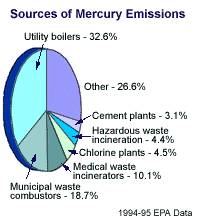I just did a series of presentations in Tempe, AZ, had a wonderful time, hope to post more.
One night, the question of mercury in compact fluorescent bulbs generated a bit of discussion.

Sources of Mercury Emissions include coal power plants (utility boilers), cement, landfills, etc. The addition of mercury to the environment is declining; after peaking in 1960, emissions have fallen more than half. US emissions dropped by 1/3 just in the 1990s. This is because mercury use is less common.
The contribution of mercury from compact fluorescents is small, smaller than the contribution of incandescent bulbs lit in part by coal power.
Heavy metal poisoning can be serious, that said, I’m not sure why mercury has grabbed the public interest, though I see environmentalist groups pushing this concern. Not to mention the US government’s focus on cleaning up coal emissions of mercury, with less public discussion of the more potent killers from coal power. While coal is the single biggest contributor to mercury in the air, mercury is far down the list of coal’s sins. Carbon dioxide, causing climate change, particulates, killing some 30,000 Americans annually and hundreds of thousands of Chinese, and ozone, killing 1,000 Americans annually and ?? Chinese, certainly are more important than mercury. Incandescent bulbs use about 4 times the electricity and create 4 times the number of deaths and illnesses, of which mercury is a minor portion.

Compact fluorescent bulbs save lives.

Incandescent bulbs are costly. If your electricity is made from coal or natural gas, incandescent bulbs are important contributors to mortality rates, environmental destruction, and a small increase in mercury emissions (though larger than the contribution from compact fluorescents).

Switching your bulbs to compact fluorescent is a good idea!
Dispose of your light bulbs as specified locally. In some places, this means collecting them until other stuff is taken in for processing. In others, it means throwing compact fluorescents out with the trash, unless you generate more than 100 kg in hazardous waste/month.
How dangerous is mercury?
It, along with cadmium, arsenic, and lead, would not be commercially affordable if they had to meet the same standards as uranium. That said, avoid breaking CFL’s regularly and there shouldn’t be too much problem. The old mercury thermometers had between 10 and 800 times as much mercury as a compact fluorescent bulb. The Japanese problems with mercury poisoning from fish occurred after industrial dumping. Don’t go out of your way to eat mercury, but don’t worry too much about the levels of mercury in CFL’s either.

nice like it
Here’s a short critique of the bogus argument that there will be a reduction in toxic mercury into the environment with CFL’s due to the energy reduction from coal plants:
(1) The EPA figures are incorrect for several reasons. The basic one is that they assume 100% of electricity in the US is from coal plants. Not true. 50% of electricity does not come from coal plants in the US and coal plants are now mandated to reduce their mercury emissions by between 70% and 90% in the next several years.
(2) Places like California produce little energy from coal plants, so CFL energy reductions will not cut much mercury there.
(3) The 5mg of mercury generally claimed for CFL’s is largely a goal and not the current reality which can be 300% to 600% higher, depending on the manufacturer. The EPA assumes just 4mg.
(4) CFL’s are made in China with energy from mostly very dirty coal plants that emit much more mercury than US coal plants.
(5) CFL’s made in China spill as much mercury into the environment as goes into the CFL’s.
(6) CFL’s are delivered here on ships using bunker oil, the worst mercury producer of the fuel oils. Incandescent bulbs are still almost all made in the US.
(7) There is no recycling program in place or planned that could handle the number of CFL’s proposed. And after many years, even the industrial recycling programs only handle 25% of the mercury from fluorescent lights.
(8) It is likely that if any major recycling program is set up, the CFL’s will be shipped back to China for reprocessing.
Thus, a massive CFL program will put a massive amount of toxic mercury into the environment and very likely into our kid’s bodies. And the EPA says that a sixth of them already have too much mercury in them. Given the danger, it might be wise to believe the EPA in this case.
Ed, thanks for your comments.
Do you have references for any of your statements?
Trying to find a picture I once saw of a coal miner standing in front of a pile of
coal holding a Fluorescent screw in lamp; caption was this is how much coal it saved by switching to this lamp.